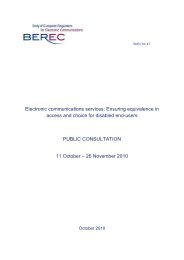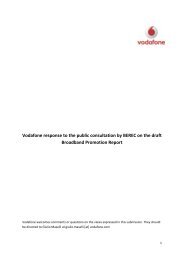BEREC REPORT ON IMPACT OF FIXED-MOBILE ... - berec - Europa
BEREC REPORT ON IMPACT OF FIXED-MOBILE ... - berec - Europa
BEREC REPORT ON IMPACT OF FIXED-MOBILE ... - berec - Europa
Create successful ePaper yourself
Turn your PDF publications into a flip-book with our unique Google optimized e-Paper software.
BoR (11) 54<br />
is extremely heterogeneous: fixed access is very high in countries such as Sweden 19 ,<br />
the Netherlands (89%) and France (87%) whereas no more than 17% of the Czech<br />
households are connected. This heterogeneity is also striking looking at mobile only<br />
households (from 2% to 81% - cf. graph hereafter) and dual access (from 15% to 94%).<br />
Source - E-communication household survey (2011)<br />
Based on this observation, the substitution of fixed-voice by mobile voice services<br />
should be assessed on a case by case basis.<br />
Without entering into a detailed case by case study two extreme patterns can be<br />
identified:<br />
a- Countries with low and decreasing fixed line penetration, offset by an increasing<br />
number of mobile only households (Czech Republic, Finland…cf. Annex 1).<br />
b- Countries with high and steady (or growing) fixed line penetration, and a large<br />
majority of dual access households (France, The Netherlands…cf. Annex 1).<br />
Based on the raw figures shown in Annex 1 (and without prejudice to the necessary<br />
country specific analysis), a trend toward increasing fixed to mobile voice access<br />
substitution may be expected for ‘pattern a countries’ other things being equal (Annex 2<br />
however provides an overview of other possible factors that might influence this trend),<br />
whereas fixed and mobile access seem to be complementary (and not substitutes) in<br />
19 Remark: E-communication household survey shows that the percentage of households having fixed telephone access<br />
in Sweden is 98%. This figure is not consistent with the evaluation made by PTS in 2010 (82%). This difference may be<br />
partially explained by different methodologies. Data collected by E-communication household Survey for Sweden should<br />
nonetheless be regarded as uncertain.<br />
19





